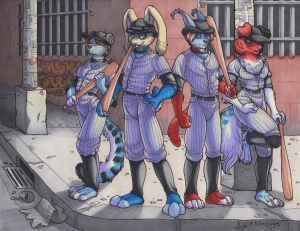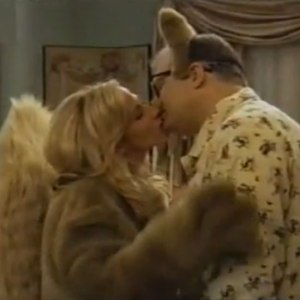Furries: A Convenient Comedic Fiction
My bar trivia team changes its name with each new tournament. Every few months, this becomes a ritual where I pitch a series of disgusting and/or esoteric names like Bridget Jones’s Diarrhea or Rod Torfulson’s Armada Featuring Herman Menderchuk and the group rolls their eyes as they reject my ideas. In the last go-around, I became insistent that we name ourselves after one of the gangs from the 1979 cult film The Warriors. For no particular reason, I especially wanted to be called The Baseball Furies. In a flash of brilliance and to my surprise, a teammate suggested that we be called The Baseball Furries – combining the fictional gang with the name for people whose sexual fetish is to dress up like a Care Bear.1
This was a good name for a trivia team, but considering their usual aversion to jokes that might offend, I was surprised that the team was amenable to this name. It was difficult for me to imagine naming our team after any minority group – sexual or otherwise. I had to conclude that everyone pretty much assumed there to be no furries in the bar, nor would there be any in our social groups that could possibly take offense.
Furries might exist somewhere, but nowhere, we assume, near us. It makes them a convenient reference for a laugh about other people’s perversion. And yet, our assumption that it is a minority group so small as to be nonexistent belies our and everyone else’s assumed familiarity with the practice. For a group that barely exists, there sure are a lot of people talking about furries. This is why the group is “fictional” – the amount of discourse that surrounds furry-ism immeasurably outweighs the reality of its practice. That it is other people’s perversion is key. Furry fetishism is so far off the radar of seemingly possible sexuality that it has come to stand in as a marker for sexual deviance in comedy. It is a common target for television comedies like The Drew Carey Show, Entourage, and Check It Out with Dr. Steve Brule. And in a comic twist on “rule 34,” furry culture is the topic of a lot of internet mockery.2
In an episode of 30 Rock, unlucky-in-love Liz Lemon finds a seemingly great guy who is single. Too good to be true? Yes – he’s a furry. This is reminiscent of the “all the good men are gay” sitcom trope where a woman falls for a gay man. One variation of this trope, which became the basis for Will and Grace, has a female character only realize at a humiliatingly late moment that her crush is gay. The key difference between Grace and Liz, however, is that while Will’s sexuality allowed the pair to easily reformulate their relationship as friends, Liz was so horrified at the prospect of furry-ism that it was borderline unimaginable for her to spend any more time with this man. And as the primary surrogate for the audience, it was implied that the we too should be comically horrified by the prospect of explorations in furry sexuality. That kind of experimentation was Jenna’s domain.
It is difficult to imagine, in the current media environment, having a character like Liz Lemon be horrified by a homosexual. Homer Simpson could get away with homophobia in 1997, as long as he learned tolerance by the end of the program. Although homophobia still exists in American comedy, the kind that would blatantly encourage a kind of abject dread is not terribly common in contemporary mass media. This is due to a host of factors, notably general changing social mores as well as more pointed calls for responsible representation by gay rights groups. Jokes constantly change their particulars while maintaining a common structure. That some gay jokes have shifted their target to furries is thus less notable than the fact that jokes have shifted from an identifiable group to a practically unidentifiable one.
And this is neither only nor simply an issue of redirected homophobia. Jeffrey Sconce provocatively suggests that “the unconscious is slowly dying out” in part because of, “the Internet’s ability to actualize any and all erotic scenarios in seconds.” From a Freudian standpoint, the lack of an unconscious would obviate the need for humor or sexual shame, so why do we seem stubbornly stuck with jokes at the expense of furries? Furry jokes demonstrate at least some aspect of the unconscious is alive and that it is desperately trying to Other furries in an attempt to normalize the things of which we are all silently ashamed. We need furries because they make your internet browser history seem less embarrassing. But beware. Once that stuff becomes normalized, there will be few places left to go for the thrill of perversion. Someday, we will all become furries.
1I am aware that sex is supposedly only a part of this subculture, but let’s be honest – that’s how everyone thinks about this group. Read on in any case, because this relates to my point.
2Rule 34 states that on the internet, if it exists, there is porn of it.
An Interview with Judith Yaross Lee. With an excerpt from “Twain’s Brand.”
Tracy Wuster
We are very excited to present this interview with Judith Yaross Lee. Judith is Professor & Director of Honors Tutorial Studies in the School of Communication Studies at Ohio University. She is the author of, among many works,Defining New Yorker Humor and Garrison Keillor: A Voice of America.
Judith is the new editor of Studies in American Humor. Through the American Humor Studies Association, and on her own, Judith has mentored many humor studies scholars, including myself. It is a pleasure to print this interview and an excerpt of her excellent and important new book: Twain’s Brand: Humor in Contemporary American Culture. (Find an Excerpt here).
Tracy Wuster: Tell me about your start in humor studies. How and when did you begin pursuing it as a subject? who has influenced you as a scholar of humor?
Judith Yaross Lee: I had the great good fortune to take a course on Mark Twain with Hamlin Hill in my first quarter of my M.A. program in English at the University of Chicago, where I was first introduced to the study of humor as an interdisciplinary historical and cultural study, largely through my ancillary reading in Henry Nash Smith, later augmented by the works of early American Studies luminaries such as Perry Miller and Leo Marx.
Then in my second year of doctoral study I had another course with Ham, a seminar in contemporary American humor in which I was one of just two students (I guess we were the only ones who trundled over to the department office to find out what the special topic was, because all our friends were jealous when they learned about it). We were so intimidated by Ham’s expertise and so worried about holding up our end of the discussion–my classmate had taken the regular course in American humor from  Walter Blair, who was retired but had filled in during Ham’s sabbatical, but I had not–that we spent huge amounts of time preparing each class. The result was that both of us had found dissertation topics by the end of the term. My dissertation covered humor in six novels by Melville, Twain, Faulkner, Nathanael West, and Philip Roth under the pompous title “To Amuse and Appall: Black Humor in American Fiction.” I never published it or any piece of it, though I revisited two of the novels in Twain’s Brand, which now that I think of it has a similarly large scope, though this time around I felt more able to manage it.
Walter Blair, who was retired but had filled in during Ham’s sabbatical, but I had not–that we spent huge amounts of time preparing each class. The result was that both of us had found dissertation topics by the end of the term. My dissertation covered humor in six novels by Melville, Twain, Faulkner, Nathanael West, and Philip Roth under the pompous title “To Amuse and Appall: Black Humor in American Fiction.” I never published it or any piece of it, though I revisited two of the novels in Twain’s Brand, which now that I think of it has a similarly large scope, though this time around I felt more able to manage it.
So obviously the Chicago school of neo-Aristotelian formalism and the Blair-Hill school of humor and Mark Twain studies influenced me from the start, as did the humor theory of Constance Rourke, whose work I felt did not have the stature it deserved. But I was mortified when, soon after defending my dissertation in 1986, I read Emily Toth’s “A Laughter of Their Own: Women’s Humor in the United States” (1984) and realized how little I knew about women humorists, so I began devouring the pioneering articles and books by Nancy Walker, whose scholarly rigor I appreciated as much as her insights, and by Regina Barreca, whose first book had such an exciting title—They used to call me Snow White– but I drifted: Women’s strategic use of humor (1991)–that I ordered it something like a year before it came out. About the same time I was also inspired and greatly helped by David Sloane, especially his bibliographic work; his American Humor Magazines and Comic Periodicals (1987) is a trove yet to be fully mined.
In the 1990s (like everyone else) I also began reading Bakhtin, whose focus on the “lower stratum” I found immediately satisfying and much more congenial than Freud’s joke theory. However, I have also been strongly influenced by communication theory–most strongly by the medium theory of Walter Ong and the performance theories of Erving Goffman–and cultural theorizing by Edward Said and W. E. B. DuBois, among others. I like Johan Huizinga on play, which I think has strong overlaps with humor as a non-instrumental form of human expression. I confess to love reading humor theory!
TW: Was there resistance from others in your field or department to the study of humor as a “non-serious” subject?
JYL: I felt a lot of encouragement from my professors at the University of Chicago. Because Ham left before I was ready to write my dissertation, however, I worked with three other Americanists, William Veeder, as director, John Cawelti, as second reader, later replaced after he left by James E. Miller, Jr. John was a pioneer of popular culture historiography and theory, so he had no qualms about my work on humor, but Bill, who worked mainly on 19th-century fiction, insisted that I prepare for a field exam in an unequivocally serious or heavy topic in order to demonstrate to a search committee that I was not an academic lightweight and that I could contribute to the core teaching mission of an English or American Studies department. (I was inclined toward the latter, but those jobs were very scarce.) That was wise advice, as my decision to do a special field in theories of literary effect as particularly relevant to humor that landed me my current position in the Rhetoric and Public Culture program in the Scripps College of Communication at Ohio University.
Humor has not been an issue at either of the two schools where I’ve been on a tenure line. My colleagues in the School of Communication Studies have promoted me through the ranks since I arrived as an advanced assistant professor in 1990. Far from exhibiting prejudice against my topic, they think of my work as hard-core traditional humanities scholarship because of my archival and historical research methods. I am grateful for their collegiality and open-mindedness.
Before Ohio I had an assistant professorship teaching composition at LaGuardia Community College/CUNY, which was a wonderful place to learn the ropes of being a teacher and faculty member. And before that, while writing my dissertation, for many years I taught composition and occasionally media theory as an adjunct. I often marvel at my good fortune at escaping the adjunct ranks.
I should note for graduate students in English and American Studies that I have not held a position in one of those departments since 1990. But other American humor studies colleagues have, so perhaps they can speak more directly to issues of the job search. Most of them, like me, have their fingers in some more conventional or highly valued pies for their teaching and research portfolios–often particular authors or themes, or in my case, media history (including periodicals) and theory. Humor colleagues probably don’t know that I published a theory of email in 1996.
TW: What have been the most interesting developments in humor studies in your time in the field?



